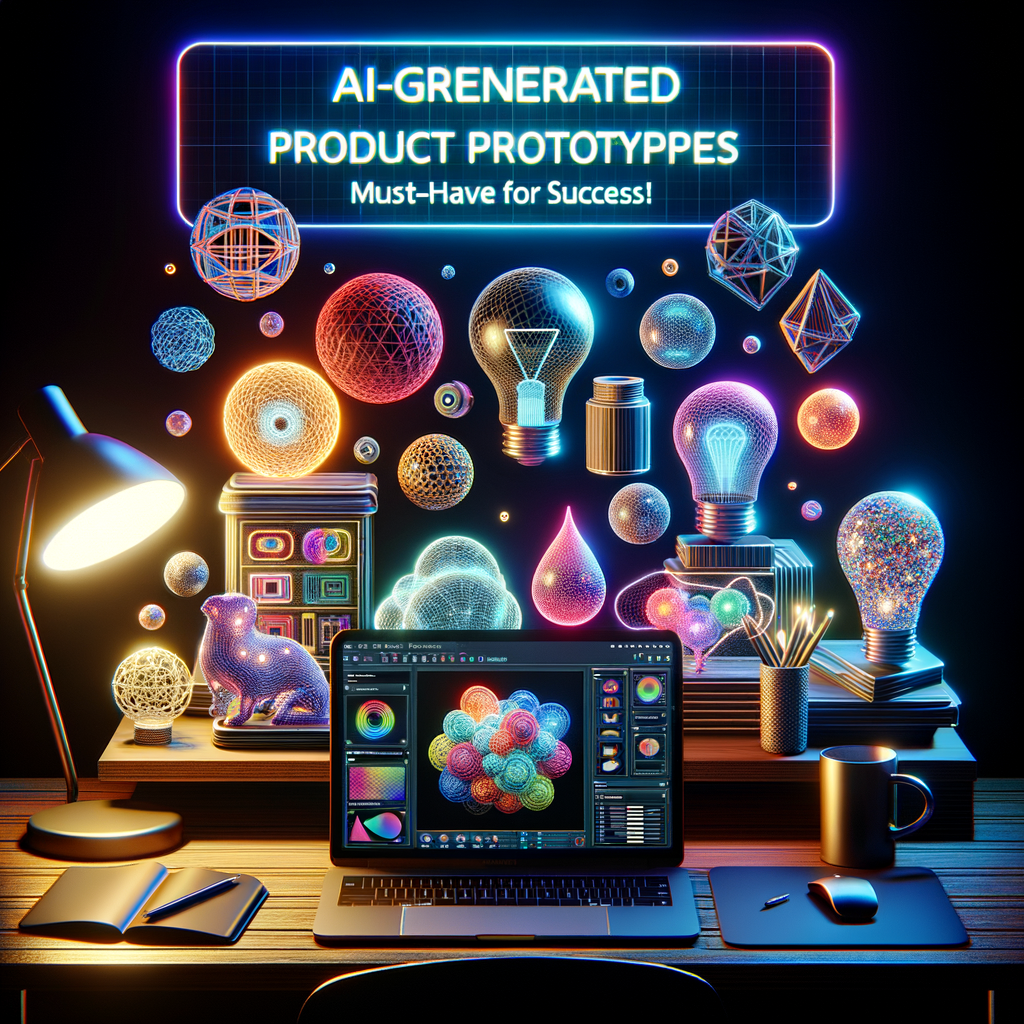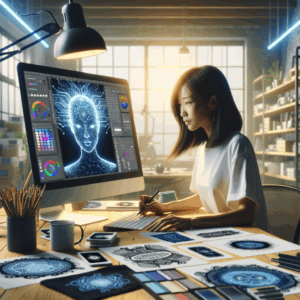
AI-Generated Product Prototypes: Must-Have For Success!
- Understanding the Value of AI-Generated Product Prototypes
- The Process Behind AI Prototyping
- Data Collection
- Algorithm Training
- Prototype Generation
- Benefits of AI-Generated Prototypes
- Faster Time to Market
- Cost Efficiency
- Enhanced Customization
- Risk Reduction
- AI Tools and Technologies in Prototyping
- Generative Design Software
- 3D Modeling Software
- Simulation Software
- Implementing AI in Product Development
- Assess Your Company’s Needs
- Choose the Right Tools
- Train Your Team
- Iterate on Feedback
- Overcoming Challenges in AI Prototyping
- Data Quality and Quantity
- Resistance to Change
- Budget Constraints
- The Future of AI in Product Prototyping
- Increased Automation
- Enhanced Collaboration
- Advanced Predictive Analytics
- Conclusion
- FAQs
- References
Understanding the Value of AI-Generated Product Prototypes
In today’s fast-paced market, businesses must innovate consistently. One of the most effective ways to streamline product development is through AI-generated prototypes. By leveraging artificial intelligence, teams can create product designs more quickly and efficiently. This technology minimizes the trial-and-error process, significantly enhancing success rates.
AI-generated prototypes use advanced algorithms to simulate user interactions and experiences. These simulations can predict how a product will perform in the real world. Not only does this save time and resources, but it also leads to better-informed decisions. As a result, businesses can enter the market faster and with a product more aligned with customer needs.
The Process Behind AI Prototyping
AI-generated prototypes follow a systematic approach that covers various stages of product design. Each stage plays a vital role in ensuring the final product meets customer expectations.
Data Collection
The first step in AI prototyping is data collection. Businesses gather information about customer preferences, market trends, and competitor products. This data acts as the backbone for the AI algorithms. By understanding what works well and what doesn’t, the AI can make better decisions for new designs.
Algorithm Training
Once the data is in hand, the next step is training the AI algorithms. Machine learning models analyze the collected data to identify patterns and insights. These insights help the AI understand what design elements resonate most with users. The more data the AI processes, the more accurate its predictions become.
Prototype Generation
After training, the AI generates design prototypes. Using various design tools, the AI creates multiple versions of a product. This process allows teams to visualize different concepts quickly. Teams can then select the best prototypes for further development.
Benefits of AI-Generated Prototypes
AI-generated prototypes offer a host of advantages. Recognizing these benefits can help businesses understand why they should adopt this approach.
Faster Time to Market
One of the most significant advantages is the speed at which teams can produce prototypes. Traditional prototyping involves meticulous planning and several iterations, each taking time and resources. AI accelerates this process by delivering multiple design options in a fraction of the time.
Cost Efficiency
Producing prototypes can be expensive. However, AI minimizes these costs. By reducing the number of physical prototypes needed, businesses can allocate those saved funds elsewhere. This economization allows companies to invest more in marketing, production, or customer engagement.
Enhanced Customization
Modern consumers demand personalized experiences. AI-generated prototypes allow teams to customize products based on user data. This level of personalization can differentiate a brand in a saturated market, leading to increased customer satisfaction.
Risk Reduction
The development of a new product carries inherent risks. Traditional prototyping requires significant investment before knowing whether a product will succeed. AI-generated prototypes allow companies to evaluate which concepts will likely work best, cutting down on wasted resources.
AI Tools and Technologies in Prototyping
Various tools and technologies facilitate AI-generated prototyping. Understanding available options can help teams select the right fit for their needs.
Generative Design Software
Generative design software leverages AI to explore numerous design alternatives based on specific constraints and performance criteria. This type of software allows teams to generate innovative solutions they may not have considered otherwise. Examples include Autodesk’s Fusion 360 and Siemens’ NX.
3D Modeling Software
3D modeling software enhances visual clarity. It allows businesses to create detailed representations of their products. Tools like Blender and SketchUp facilitate rapid adjustments and iterations based on feedback.
Simulation Software
Simulation software helps test prototypes interactively before they go into production. Programs like Ansys and Simul8 enable teams to assess performance under various scenarios. This testing phase can save companies from costly mistakes down the line.
Implementing AI in Product Development
Integrating AI into product development requires careful thought and planning. Here’s a step-by-step guide to ensure a smooth implementation.
Assess Your Company’s Needs
The first step is to assess your company’s specific needs. What problems do you hope to solve with AI prototypes? Understanding this allows you to choose the right tools and strategies.
Choose the Right Tools
Based on your needs assessment, select the appropriate software and tools. Consider factors like usability, cost, and scalability. Engaging with vendors and trying out demos can help you make an informed decision.
Train Your Team
AI is a powerful tool, but only if your team knows how to use it. Offering training can enhance your team’s skills and boost productivity. A well-rounded understanding helps everyone leverage the technology effectively.
Iterate on Feedback
Once you start using AI-generated prototypes, gather feedback from relevant stakeholders. Continuous iteration based on this feedback ensures that the prototypes meet user needs and expectations.
Overcoming Challenges in AI Prototyping
While the benefits of AI-generated prototypes are clear, challenges may arise. Acknowledging these obstacles can help organizations stay prepared and adaptable.
Data Quality and Quantity
AI is only as good as the data fed into it. Poor-quality data can lead to inaccurate prototypes. Ensuring data quality and relevance through meticulous collection processes is crucial. Furthermore, more data often leads to better outcomes.
Resistance to Change
Some team members may resist adopting new technologies. Change can be daunting, especially in established workflows. Fostering a culture of innovation and explaining the benefits can help ease this transition.
Budget Constraints
While AI can save money, initial investments in tools and training can be high. Prioritize features that align most closely with your goals. This ensures that you’re making the most of your investment.
The Future of AI in Product Prototyping
Technology continues to evolve rapidly. As we look to the future, the role of AI in product prototyping will likely expand.
Increased Automation
Automation will streamline the entire prototyping process. As AI technologies improve, the reliance on human intervention will decline. This can lead to unprecedented efficiency in product design cycles.
Enhanced Collaboration
AI can facilitate better collaboration between teams. Real-time data access and analysis will allow teams to work more cohesively. Such collaboration fuels creativity and leads to innovative solutions.
Advanced Predictive Analytics
Future advancements in predictive analytics will further enhance AI’s capabilities in prototyping. By using even more sophisticated algorithms, businesses will be able to anticipate market trends more accurately. This foresight will empower companies to produce products that meet emerging consumer demands.
Conclusion
The use of AI-generated product prototypes is essential for businesses striving for success. This technology provides faster, cost-efficient, and customizable solutions that align closely with customer desires. As companies face increasing competition, adopting AI-driven strategies will become not just beneficial, but necessary.
Failing to leverage AI can lead businesses to miss vital opportunities for innovation. Therefore, investing in AI-generated prototypes isn’t just about keeping up; it’s about leading the way into a future where these capabilities become the standard.
FAQs
1. What is an AI-generated product prototype?
It’s a digital representation of a product crafted using artificial intelligence. The AI uses data to create designs that predict user interaction.
2. How does AI improve the prototyping process?
AI speeds up design iterations, reduces costs, and enhances customization based on real-time data analytics.
3. What types of businesses benefit from AI prototypes?
Any company that develops products can benefit, including tech, fashion, automotive, and consumer goods industries.
4. Can AI-generated prototypes guarantee success?
While they can significantly improve the odds of success, no prototype guarantees market success due to variable consumer preferences and market conditions.
5. How do businesses implement AI in their prototyping?
Implementing AI involves assessing needs, selecting suitable tools, training teams, and iterating based on feedback.
6. What are some popular AI prototyping tools?
Popular tools include Autodesk’s Fusion 360, Siemens’ NX, Blender, and Ansys for simulation.
7. Are there ethical concerns around AI in prototyping?
Yes, ethical concerns exist, particularly around data privacy and the potential for biased algorithms.
8. How long does it take to create an AI-generated prototype?
The time varies depending on the complexity of the product and the amount of data available. However, it is generally much quicker than traditional methods.
9. Can AI handle multiple prototypes simultaneously?
Absolutely! AI can generate numerous prototypes at once, allowing teams to explore a variety of options rapidly.
10. What should teams consider when using AI prototypes?
Teams should focus on data quality, training, and the alignment of prototypes with customer needs to maximize their effectiveness.
References
– Autodesk. (n.d.). Fusion 360. Retrieved from Autodesk
– Siemens. (n.d.). NX. Retrieved from Siemens
– Ansys. (n.d.). Simulation Software. Retrieved from Ansys
– Blender. (n.d.). A Free and Open Source 3D Creation Suite. Retrieved from Blender
– SketchUp. (n.d.). 3D Modeling Software. Retrieved from SketchUp

